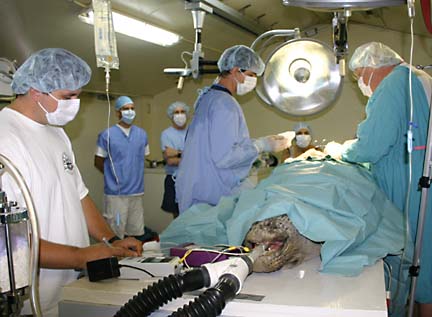
A team of veterinarians worked yesterday on a sedated 500-pound Hawaiian monk seal, known as TT-40, in an effort to remove a fishing hook from its esophagus.
Surgery on monk seal
is deemed a successIt takes 5 1/2 hours to remove
a fishhook from its esophagus
Veterinarians successfully removed a fishhook in a 5 1/2-hour surgery yesterday from the esophagus of an endangered Hawaiian monk seal found injured on Kauai last week.
The difficult part of the operation was extending the anesthesia and stitching up the seal, veterinarians said, noting that locating the hook and removing it was easier than expected.
Veterinarians used more than 200 stitches to close up layers of the seal's abdomen, blubber and skin. The incision on the seal's stomach was about 12 inches long.
The seal is doing well at the Marine Corps Base Hawaii in Kaneohe, and veterinarians say the prognosis is good.
Veterinarians anticipated the surgery to be more than two hours long but were surprised it took more than five hours.
"It was a lot more complicated than we hoped it would be," said Dr. Martin Haulena, a veterinarian from Marine Mammal Center in Sausalito, Calif., who anesthetized the seal.
The 5-inch hook caused some tissue tearing and damage in the esophagus, said Dr. Robert Braun, a veterinarian with the National Marine Fisheries Service.
The 500-pound, 20-year-old male Hawaiian monk seal, known as "TT-40" on its flipper identification tag, is recovering at Marine Corps Base Hawaii, where the surgery was performed from 8:26 a.m. to 1:54 p.m.
Braun said the chances of survival are better now that the hook is removed, but they will be observing it closely for the next two weeks.
"The next 24 hours will be critical," Haulena said.
Veterinarians fear that the stitches might weaken or the area could get infected in the next couple of days. They hope to bring the seal back into a pool today and feed it "very digestible" fish tomorrow, Braun said. They will transport it back to Kewalo Research facility tomorrow.
After veterinarians are sure that the seal has recovered, can eat on its own and does not pose a threat to other marine animals, they will release it back into the ocean.
On Tuesday, veterinarians were unsuccessful in removing the hook.
National Oceanographic and Atmospheric Administration officials captured TT-40 last Thursday in Waimea, Kauai. U.S. Coast Guard officials airlifted the seal to Oahu in a C-130 cargo plane the following day.
Local community centers aided veterinarians by supplying the surgical instruments.
— ADVERTISEMENTS —
— ADVERTISEMENTS —
